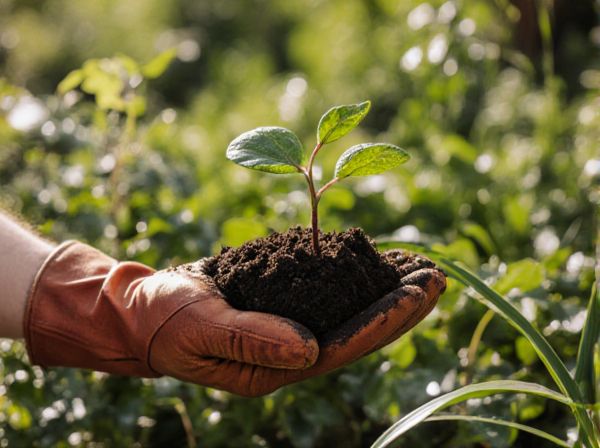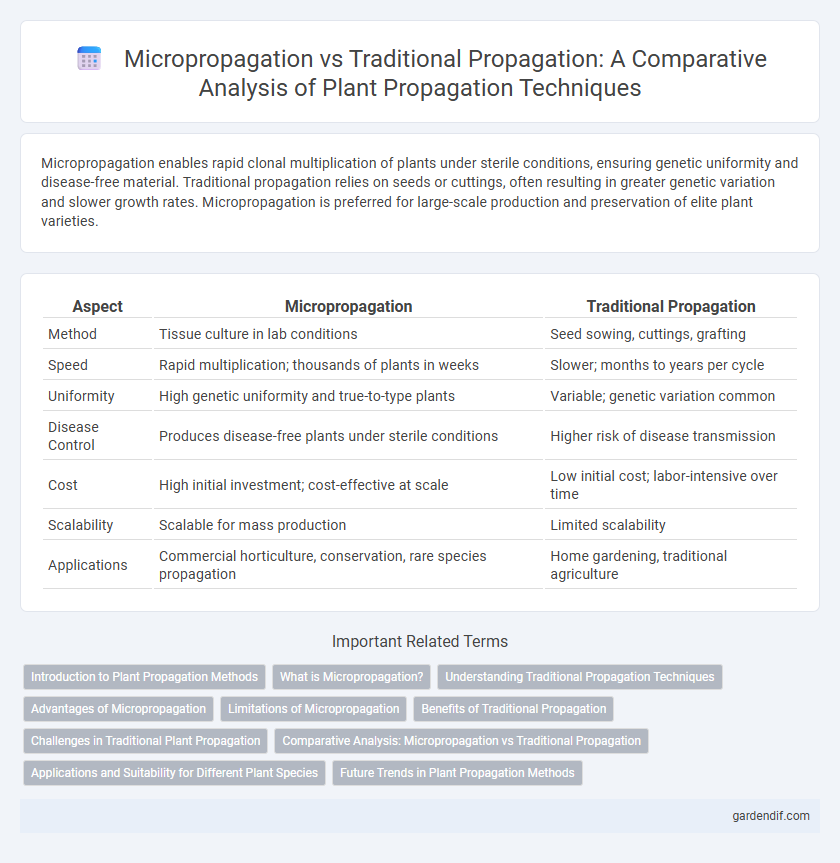
Micropropagation vs Traditional Propagation Illustration
Micropropagation enables rapid clonal multiplication of plants under sterile conditions, ensuring genetic uniformity and disease-free material. Traditional propagation relies on seeds or cuttings, often resulting in greater genetic variation and slower growth rates. Micropropagation is preferred for large-scale production and preservation of elite plant varieties.
Table of Comparison
| Aspect | Micropropagation | Traditional Propagation |
|---|---|---|
| Method | Tissue culture in lab conditions | Seed sowing, cuttings, grafting |
| Speed | Rapid multiplication; thousands of plants in weeks | Slower; months to years per cycle |
| Uniformity | High genetic uniformity and true-to-type plants | Variable; genetic variation common |
| Disease Control | Produces disease-free plants under sterile conditions | Higher risk of disease transmission |
| Cost | High initial investment; cost-effective at scale | Low initial cost; labor-intensive over time |
| Scalability | Scalable for mass production | Limited scalability |
| Applications | Commercial horticulture, conservation, rare species propagation | Home gardening, traditional agriculture |
Introduction to Plant Propagation Methods
Micropropagation is a tissue culture technique that produces large numbers of genetically identical plants rapidly under controlled, sterile conditions, offering advantages in disease-free plant production and genetic uniformity. Traditional propagation methods, such as seed sowing, cuttings, grafting, and layering, rely on natural growth processes and are often influenced by environmental factors and genetic variability. Micropropagation enables consistent plant quality and accelerated multiplication rates compared to conventional propagation techniques.
What is Micropropagation?
Micropropagation is a tissue culture technique that enables rapid multiplication of plants by growing small plant sections, such as meristems or explants, in a sterile, nutrient-rich medium under controlled laboratory conditions. This method produces genetically uniform and disease-free plants much faster than traditional propagation methods like seed germination or cuttings. Micropropagation is widely used in agriculture and horticulture to produce large numbers of high-quality plants with consistent traits.
Understanding Traditional Propagation Techniques
Traditional propagation techniques involve methods such as seed sowing, cuttings, layering, and grafting to reproduce plants naturally. These approaches rely heavily on the plant's biological processes and environmental conditions, often resulting in genetic variation among offspring. Understanding traditional propagation is essential for choosing the appropriate method based on the species, growth cycle, and desired genetic traits.
Advantages of Micropropagation
Micropropagation enables rapid production of a large number of genetically uniform and disease-free plants, surpassing the scale achievable through traditional propagation methods. This technique ensures year-round propagation independent of seasonal constraints, significantly reducing the time needed to produce mature plants suitable for commercial use. Enhanced genetic stability and higher success rates in tissue culture environments make micropropagation a superior choice for conservation and large-scale horticultural production.
Limitations of Micropropagation
Micropropagation faces limitations such as high initial setup costs, the requirement for sterile laboratory conditions, and the potential for genetic mutations during tissue culture processes. Unlike traditional propagation methods, micropropagation can result in somaclonal variation, which affects uniformity in plant offspring. Moreover, not all plant species respond well to micropropagation, limiting its applicability across diverse crops.
Benefits of Traditional Propagation
Traditional propagation preserves genetic diversity by using seeds or cuttings, which ensures natural variation essential for ecosystem adaptability. It is cost-effective and requires minimal specialized equipment, making it accessible to small-scale farmers and gardeners. This method supports plant robustness through natural environmental interactions, often resulting in stronger, more resilient plants compared to micropropagated ones.
Challenges in Traditional Plant Propagation
Traditional plant propagation faces challenges such as inconsistent growth rates, susceptibility to diseases, and limited availability of quality planting material. Environmental factors and pests often reduce survival rates and yield uniformity. Micropropagation offers a controlled, disease-free environment that overcomes these limitations by producing large quantities of genetically identical plants.
Comparative Analysis: Micropropagation vs Traditional Propagation
Micropropagation offers rapid multiplication of genetically identical plants with higher disease control compared to traditional propagation, which relies on seeds or cuttings and is slower but more cost-effective for large-scale outdoor cultivation. Traditional propagation often results in greater genetic variability, which can be advantageous for breeding programs, whereas micropropagation ensures uniformity and consistency in crop quality. The choice between these methods depends on goals like speed, scale, genetic uniformity, and resource availability in agricultural practices.
Applications and Suitability for Different Plant Species
Micropropagation is highly suitable for mass-producing disease-free plants, especially for species with slow or difficult seed germination such as orchids and bananas. Traditional propagation remains preferred for plants with readily available seeds and for those where genetic variation is desired, like many fruit trees and vegetables. Applications of micropropagation excel in commercial horticulture and conservation efforts, while traditional methods are widely used in home gardening and large-scale agriculture where cost and simplicity are key factors.
Future Trends in Plant Propagation Methods
Micropropagation harnesses tissue culture technology to rapidly produce genetically uniform and disease-free plants, promising scalability and consistency that traditional propagation methods cannot match. Advances in automation and bioreactor systems are expected to reduce costs and labor intensity, making micropropagation more accessible for commercial horticulture. Integration of gene editing and synthetic biology with micropropagation techniques suggests a transformative future for producing climate-resilient and high-yield crop varieties.
Micropropagation vs Traditional Propagation Infographic

 gardendif.com
gardendif.com